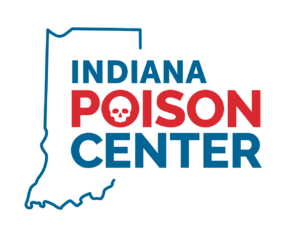Summertime is winding down, but there are still plenty of chances left to enjoy some outdoor activities, such as blowing bubbles and drawing with sidewalk chalk. And, according to the Indiana Poison Center’s statistics, drinking bubbles and nibbling on the chalk!
What do you do if you catch your child sipping from the bottle of blowing bubbles? Don’t get too upset! Give us a call at 1-800-222-1222. We can help! Bubbles typically contain a low concentration of soap and sidewalk chalk is non-toxic. While a sip or a bite or two, respectively, is not a concern, that isn’t the case with all art and craft supplies.
It is important to provide safe products for children in your care to use. We suggest checking labels on all art and crafting materials, and only using those identified as safe to be used for children under the age of 12 years. This is not always easy to determine. Some materials contain toxic or harmful chemicals, but their labels will have inadequate information about ingredients or precautions, such as whether they are safe for children.
Some things to remember:
- Always read the packaging label on arts and crafts products. Follow carefully the directions and precautions listed on the label.
- If the arts and crafts product label does not have enough information for you to decide whether it’s safe, contact the Indiana Poison Center at 1-800-222-1222.
How to understand product labels:
- Nontoxic – When a manufacturer advertises a product as “nontoxic” it means the product has passed the acute or short-term toxicity test required by the Federal Hazardous Substance Act. Nothing, however, is implied about the product’s long-term toxicity. Therefore, materials that may cause long-term toxicity and/or may cause minor illness if swallowed, could carry a “nontoxic” label.
- Meets American Society for Testing Materials (ASTM) regulations for chronic long-term health – To address the issue of long-term toxicity, the 1990 Labeling of Hazardous Art Materials Act required that any art and craft materials that present a chronic hazard bear a statement warning of the hazard and an additional warning that it is inappropriate for use by children. The Act directed the Consumer Product Safety Commission to set guidelines determining whether arts and crafts present chronic long-term hazards to both adults and children. All arts and crafts materials must identify the hazardous ingredients, provide guidelines for safe use, identify that the product complies with Federal Law, and provide a telephone number for the consumer to request additional information. This information must appear on the label, the packaging, or the display for the product. Although this law has been in effect for more than 10 years, there are still products on the market, especially imported art products, which are not in compliance.
The law requires labeling of such products as solvents, spray paints, silk screen inks, adhesives, and materials that contain chemicals that are hazardous if inhaled, absorbed or swallowed.
- Certified Products (CP) or approved (AP) – The Certified Product (CP) or Approved Product (AP) seal identifies some art materials as safe for use by children. To carry either of these seals, an authority on toxicology from the Art and Craft Materials Institute must have evaluated the product. This certification means there are no materials in the art product in sufficient quantity to be toxic or to injure the body even if ingested.
Certified or Approved Products include crayons, water colors, tempera colors, finger paints, chalks, modeling materials, pencils, block printing inks, gel pens, drawing inks, etching inks, screen printing inks, school paste, adhesives, acrylic and oil paint, marking crayons and other art materials. Products bearing the AP seal are nontoxic even if ingested. Those bearing the CP seal are nontoxic even if ingested and meet or exceed specific quality standards of material, workmanship, working qualities and color. Carefully read labels to identify products that are certified and approved by the Arts and Crafts Materials Institute. Refrain from eating or drinking while using these products and wash your hands thoroughly when finished.
When choosing art supplies, some products to avoid include:
- Powdered tempera paints, pastels, chalks or dry markers that create dust.
- Instant papier-mâché (may contain asbestos fibers and lead from pigments in colored printing inks)
- Oil based paints, turpentine, benzene, toluene, and rubber cement and its thinner
These products can be used instead:
- Natural dyes, such as dyes made from vegetables, onion skins, tea, flowers, and other food dyes
- Papier- mâché made from black and white newspaper and library paste, white paste, or flour and water paste.
- Water-based paints, glues, inks, etc.
Remember, the experts at the Indiana Poison Center are standing by – 24 hours a day, 365 days a year. Just call (800) 222-1222 for help with craft supply questions and poison emergencies alike.
